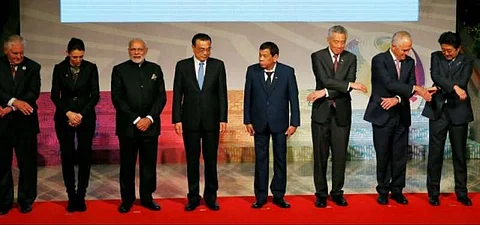
- Home
- Live Blog
- Breaking News
- Top Headlines
- Cities
- NE News
- Sentinel Media
- Sports
- Education
- Jobs

The upcoming East Asia and ASEAN summits this week promise to give more impetus to New Delhi’s Indo-Pacific vision, and the part its ‘Act East’ policy plays in this scheme of things. Prime Minister Narendra Modi will be travelling to Singapore with a packed schedule, in particular multi-lateral talks on Regional Comprehensive Economic Partnership (RCEP) which is rapidly taking shape, along with crucial one-to-one talks with several leaders. The focus will be on RCEP, the multi-lateral Asia-Pacific free trade bloc to be composed of 10 ASEAN members plus the 6 partners China, India, Japan, South Korea, Australia and New Zealand. This China-driven 16 member bloc covering half the world’s population would be the mother of all trading blocs, and chances are bright that a broad pact could be announced in Singapore in a clear message to the US. Thanks to President Donald Trump’s pursuit of bilateral deals to extract maximum benefits for the US, other major countries have been holding up multilateralism as a better deal for emerging economies seeking new markets. The first casualty of Trump’s ‘America First’ policy — the 12-member Trans-Pacific Partnership (TPP) from which he pulled the US out early in 2017 — will come into force by December 30 this year. It will be an 11-member Pacific rim trading bloc, with Canada, Mexico, Japan, Australia, New Zealand and Singapore already ratifying the pact. Shorn of US participation which would have made it represent 40 percent of the global economy, this bloc rechristened the ‘Comprehensive and Progressive Agreement for Trans-Pacific Partnership’ (CPTPP) will now account for 14 percent of global economy. More importantly, it will start as a major trading bloc that keeps out China, the world’s second largest economy, while still keeping the door open for the US to re-enter at a later date as well as take aboard the likes of South Korea and Colombia. This in turn has spurred China to push RCEP, the talks for which kicked off in 2012, as a mega bloc that will scrap trade barriers and integrate markets to promote free flow of goods, services and investment capital. While it remains to be seen what protection this pact will give to labour, intellectual property rights and the environment, the Chinese leadership’s keenness to get Indo-Pacific RCEP going to counter Pacific rim CPTPP is understandable.
How dextrously India plays its cards with RCEP will also be watched, considering New Delhi’s staunch opposition to China’s Belt-and-Road Initiative (BRI) which also links up with Pakistan through Pak-occupied Kashmir. Overall, it has not been smooth sailing for Beijing to get this Silk Road economic belt up and going, which will cement China as the engine in a vast inter-connected market stretching from Southeast and East Asia to Central Asia and the Middle East and beyond to Africa and Europe. But there has already been a pushback even from countries receiving Chinese largesse — like Laos, Thailand, Myanmar, Sri Lanka and Djibouti worried about getting pushed into debt traps. Pakistan, after welcoming the 62 billion dollar China-Pakistan Economic Corridor, is already seeking ways and means to reduce dependence on Chinese investment, as seen in Prime Minister Imran Khan’s efforts to negotiate better terms in Beijing recently. Notably, the Chinese leadership has been wooing Japan to get her firmly aboard on BRI; Japan has responded strongly, which is seen as Tokyo’s eagerness to attract more business and strengthen other options to an increasingly isolationist and unilateralist US. India too is faced with compulsions of widening its hedges vis-a-vis an unpredictable US, despite Washington’s drive to bring about ‘convergence’ of American interests in keeping Indo-Pacific region “free and open” with New Delhi’s Act East policy. So far, this ‘convergence’ has been more about strengthening strategic and defence ties and less about trade. But things might change, and there could be a reversal of US retreat in the Indo-Pacific that has allowed China and Russia to move more assertively in the vacuum. One such indication has come from President Trump recently okaying a new foreign aid agency, the US International Development Finance Corporation, which can lend 60 billion dollars to American companies setting up shop in developing countries. Considering Trump’s hitherto strident opposition to overseas funding, this move is being interpreted as Washington’s renewed determination to counter Chinese investment power. As for India’s Northeast, whether this region will be a key link in the chain being forged across South East and East Asia will depend on how New Delhi uses it as a springboard. The Act East Forum set up by India and Japan last year for better cooperation in the Northeast, followed in October this year by the vision statement of Prime Ministers Narendra Modi and Shinzo Abe focusing on infrastructure, connectivity and environment management projects, ought to be given concrete shape soon.